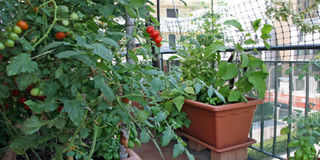Ways to grow crops on a small garden

What you need to know:
Double-digging helps in increasing soil drainage and aeration and is mostly used when cultivating soils in a new garden
As concrete buildings stand proudly on spaces that were once used for farming in both urban and rural areas, farmers have no option but to seek alternative ways of producing food.
These include use of kitchen gardens that allow one to grow food crops in tiny spaces and off the ground.
Allan Ahimbisibwe an agronomist at Spark Agro-Initiatives Africa in Kampala notes that before establishing such a farm, one should consider the amount of space available, the plants to grow and amount of time they wish to dedicate tending to the crop.
For instance, if one wants to grow 10 vegetable plants, they may use old tyres while for 50, they can go for terrace gardens.
Seeds of Gold brings you six kitchen gardens that you can use to grow a variety of crops in a tiny space, guaranteeing yourself not only quality but also safer food.
Waste pipes multi-storey garden
This is a kitchen garden made out of plastic pipes. The six-inch pipes are mounted on wooden frames that have been cut in half. The garden is suitable for people living in both urban and peri-urban areas. It can be used to grow assorted crops ranging from vegetables such as sukuma wiki, spinach to celery, carrots, cabbage and fruits such as strawberries.
A single row of the pipes can hold up to eight crops, which if well-tended can sustain a family of four for months.
One only needs two six-inch pipes, timber or bamboo trunks, with the entire garden needing about Shs200,000.
As with most kitchen gardens, the chances of pest and disease infestation are minimal.
Terrace farming
The gardens can be made from anything, from plastic tanks, plywood, old iron sheets or tyres, depending on the size. If using a plastic tank, it is cut in half, and each half is then perforated at the bottom to ensure some water drains as the opening is filled with a mixture of soil and manure in a ratio of 1:1. If one is using iron sheets, they only need to curve them in a semi-circular shape.
The gardens are ideal for farmers living in urban areas, enabling them to turn their homes into micro or macro farms. Besides vegetables such as spinach, onions and sukuma wiki, one can also plant strawberries in the garden.
Multi-storey garden
Sacks or nets are most preferred for a multi-storey garden. All a farmer needs is an empty 90 kilogramme gunny bag that is open on both ends, a wheelbarrow of well-decomposed manure, about eight kilogrammes of small stones, one metre waste pipe and 40-60 litres of water. One should then identify an area with plenty of sunlight and afternoon shade since vegetables do well in six to eight hours of full sun exposure.
“You excavate at most one foot depending on the composition of your soil and mix it with manure thoroughly before placing the one metre waste pipe upright at the centre of the sack,” says Margaret Wandeto, an agronomist.
A farmer then puts the pebbles into the waste pipe and then spreads the soil and manure mixture around the pipe and water adequately after every one foot until the bag fills up.Holes are made at 15cm from the top of the multi-storey garden using a stick or a knife.
“A farmer then puts seedlings into a hole, making sure they firm the soil around it until the whole multi-storey garden is planted,” says Wandeto, adding that one can choose to intercrop spinach with spring onions or sukuma wiki.
Oasis gardens
This is ideal during the dry season for a constant supply of vegetables or fruits all year round should the rains delay or fail altogether. A farmer requires to dig two-feet-deep and one-metre-wide trench and once they scoop out the soil, they should spread a polythene paper on the floor.
The polythene should be long enough to appear at the ground level.
A farmer then places a horizontal PVC pipe that is perforated running up to the middle of the trench and an L-joint is made at the beginning where half the pipe will appear on the ground.
One then places hard-core stones on top of the PVC pipe, before adding a mixture of manure and soil to the trench in a ratio of 1:1.
“Once the vegetables are planted, the farmer is supposed to pour water through the vertically placed pipe,” says Wandeto, adding that the pipe supplies water to the soil, while the polythene underground prevents seeping of water underground, enabling crops to flourish.
Conical garden
To make the garden, a farmer can use anything with a cyclical shape placed in the form of staircases.
The vegetables planted cascade from the bottom to the top and can go as high as the farmer desires.
According to Wandeto, one starts by planting at spaces at the bottom before proceeding to the next levels.
A farmer can curve old iron sheets into a circular form, depending on the space available, and then place old tyres inside, depending on size, to form a beautiful pattern.
One is only required to mix soil and manure in a ratio of 1:1 to produce enough for the family and surplus for the market. According to the agronomist, one can intercrop various crops, which enhance nutritional value of households diets and helps curb pests and diseases.
Sunken garden
This is a technique that can be used in both arid and semi-arid areas due to unavailability of water.
The sunken garden helps conserve water, curb runoff or soil erosion as well as provide adequate cooling for plant roots.
To make a sunken garden, one digs a two-foot-deep and one-metre-wide ditch, double-digs the soil and then adds manure and mixes it thoroughly. Double-digging helps in increasing soil drainage and aeration and is mostly used when cultivating soils in a new garden.
“Double-digging allows soil to hold water for longer, which ensures that crops grow to maturity. The bed retains moisture while using small amounts of waste water flowing from the house,” says Wandeto, noting all kinds of vegetables will grow well in such a garden.




